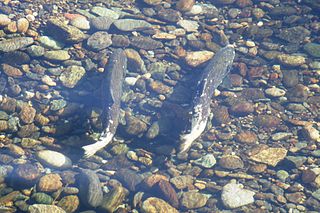Three groups monitor coho spawning in the Lagunitas Watershed. Marin Municipal Water District (MMWD) monitors the mainstems of Lagunitas and San Geronimo Creeks, the Park Service monitors Olema Creek, and SPAWN monitors eight tributaries of San Geronimo Creek.
This winter SPAWN found native endangered coho salmon in Woodacre and Arroyo Creeks. This season two redds (coho salmon nests made underwater) and six fish were found on Woodacre Creek, and another four redds and seven fish were found on Arroyo Creek. No spawning was documented in the other six tributaries this season.
In some previous years salmon were seen on all eight tributaries, but this year across the entire watershed the numbers are low. Watershed-wide, roughly 100 redds have been counted so far this season. Last year, nearly 150 redds were counted and the average for the past 20 years has been 200 redds. The U.S. government has set the “recovery goal” for Lagunitas Watershed at 2,600 adults per year.
The public often associates good spawning numbers with rainfall the same year, but in reality, this has little to do with the number of returning spawners, though it can impact where in the watershed coho spawn. For example, if water flows are not adequate to allow fish to jump the Inkwells or maneuver through culverts under roads, spawning numbers in San Geronimo Creek will be lower, but those fish probably end up spawning downstream in Lagunitas Creek.
It is rainfall patterns the two years previous that have the greatest impact on the number of returning spawners because large storm events can kill the small juvenile fish that unfortunately have few places to shelter because development pressures have simplified creek habitat through bank armoring, removing woody debris and incised creeks that no longer overflow their banks onto floodplains that have been developed and filled.
The number of returning spawners is also dependant on the condition of the juvenile fish that migrate to the ocean. Healthy watersheds produce large, healthy smolts (the name for the coho life stage as they migrate to the sea) and these fish have the best chance of surviving in the ocean to return to our creeks to spawn. So it is a combination of the number of fish that survive in our creeks and successfully migrate to the ocean, as well as their health status. Lastly, of course, it is ocean conditions as well. Good upwellings bring lots of food for the fish to grow and survive.
The message is clear: we must do everything we can to protect our creek habitats in order save these fish from extinction.
Special thanks to volunteers and interns Aaron Heller, Ryan Fox-Horn, Kim Horrell, Zephyr Sylvester, Allie Chavez, and Annie Hines who consistently showed up and lent a hand to survey the creeks and search for endangered fish. Surveys have been on-going since the third week in November and will end in February.
Please take action to help SPAWN protect these endangered fish 1.) by joining SPAWN for a volunteer restoration event here and by 2.) signing our petition asking the Marin County Board of Supervisors to protect our endangered coho salmon here.




